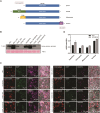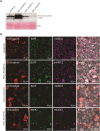A genetically encoded fluorescent heme sensor detects free heme in plants
- PMID: 38762898
- PMCID: PMC11444292
- DOI: 10.1093/plphys/kiae291
A genetically encoded fluorescent heme sensor detects free heme in plants
Abstract
Heme is produced in plants via a plastid-localized metabolic pathway and is subsequently distributed to all cellular compartments. In addition to covalently and noncovalently bound heme, a comparatively small amount of free heme that is not associated with protein is available for incorporation into heme-dependent proteins in all subcellular compartments and for regulatory purposes. This "labile" fraction may also be toxic. To date, the distribution of the free heme pool in plant cells remains poorly understood. Several fluorescence-based methods for the quantification of intracellular free heme have been described. For this study, we used the previously described genetically encoded heme sensor 1 (HS1) to measure the relative amounts of heme in different plant subcellular compartments. In a proof of concept, we manipulated heme content using a range of biochemical and genetic approaches and verified the utility of HS1 in different cellular compartments of Arabidopsis (Arabidopsis thaliana) and tobacco (Nicotiana tabacum and Nicotiana benthamiana) plants transformed either transiently or stably with HS1 and HS1(M7A), a variant with lower affinity for heme. This approach makes it possible to trace the distribution and dynamics of free heme and provides relevant information about its mobilization. The application of these heme sensors will create opportunities to explore and validate the importance of free heme in plant cells and to identify mutants that alter the subcellular allocation of free heme.
© The Author(s) 2024. Published by Oxford University Press on behalf of American Society of Plant Biologists.
Conflict of interest statement
Conflict of interest statement. None declared.
Figures






Similar articles
-
An Arabidopsis GluTR binding protein mediates spatial separation of 5-aminolevulinic acid synthesis in chloroplasts.Plant Cell. 2011 Dec;23(12):4476-91. doi: 10.1105/tpc.111.086421. Epub 2011 Dec 16. Plant Cell. 2011. PMID: 22180625 Free PMC article.
-
Pea early-browning virus-mediated genome editing via the CRISPR/Cas9 system in Nicotiana benthamiana and Arabidopsis.Virus Res. 2018 Jan 15;244:333-337. doi: 10.1016/j.virusres.2017.10.009. Epub 2017 Oct 16. Virus Res. 2018. PMID: 29051052
-
The Ca(2+) status of the endoplasmic reticulum is altered by induction of calreticulin expression in transgenic plants.Plant Physiol. 2001 Jul;126(3):1092-104. doi: 10.1104/pp.126.3.1092. Plant Physiol. 2001. PMID: 11457960 Free PMC article.
-
Transcriptional and post-transcriptional controls for tuning gene expression in plants.Curr Opin Plant Biol. 2023 Feb;71:102315. doi: 10.1016/j.pbi.2022.102315. Epub 2022 Nov 30. Curr Opin Plant Biol. 2023. PMID: 36462457 Free PMC article. Review.
-
Monitoring nutrients in plants with genetically encoded sensors: achievements and perspectives.Plant Physiol. 2023 Aug 31;193(1):195-216. doi: 10.1093/plphys/kiad337. Plant Physiol. 2023. PMID: 37307576 Free PMC article. Review.
Cited by
-
Regulatory and retrograde signaling networks in the chlorophyll biosynthetic pathway.J Integr Plant Biol. 2025 Apr;67(4):887-911. doi: 10.1111/jipb.13837. Epub 2025 Jan 24. J Integr Plant Biol. 2025. PMID: 39853950 Free PMC article. Review.
-
Unveiling subcellular secrets: A novel sensor to visualize heme distribution in plants.Plant Physiol. 2024 Oct 1;196(2):691-692. doi: 10.1093/plphys/kiae388. Plant Physiol. 2024. PMID: 39041413 Free PMC article. No abstract available.
References
MeSH terms
Substances
Grants and funding
LinkOut - more resources
Full Text Sources
Research Materials
Miscellaneous

